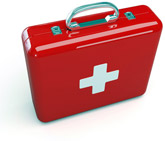First Aid Kit
 To be prepared for emergencies, keep a first aid kit in your home and in your car and find out the location of first aid kits where you work. First aid kits come in many shapes and sizes and can be purchased at many local stores.
To be prepared for emergencies, keep a first aid kit in your home and in your car and find out the location of first aid kits where you work. First aid kits come in many shapes and sizes and can be purchased at many local stores.
Anatomy Of A First Aid Kit
Some kits are designed for specific activities, such as hiking, camping or boating. Whether you buy a first aid kit or put one together, make sure it has all the items you may need. Include any personal items such as medications and emergency phone numbers or other items your health‐care provider may suggest. Check the kit regularly. Make sure the flashlight batteries work. Check expiration dates and replace any used or out‐of‐date contents. The Red Cross recommends that all first aid kits for a family of four include the following:
- 2 absorbent compress dressings (5 x 9 inches)
- 25 adhesive bandages (assorted sizes)
- 1 adhesive cloth tape (10 yards x 1 inch)
- 5 antibiotic ointment packets (approximately 1 gram)
- 5 antiseptic wipe packets
- 2 packets of aspirin (81 mg each)
- 1 blanket (space blanket)
- 1 breathing barrier (with one‐way valve)
- 1 instant cold compress
- 2 pair of nonlatex gloves (size: large)
- 2 hydrocortisone ointment packets (approximately 1 gram each)
- Scissors
- 1 roller bandage (3 inches wide)
- 1 roller bandage (4 inches wide)
- 5 sterile gauze pads (3 x 3 inches)
- 5 sterile gauze pads (4 x 4 inches)
- Oral thermometer (non‐mercury/nonglass)
- 2 triangular bandages
- Tweezers
- First aid instruction booklet
